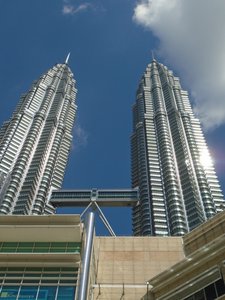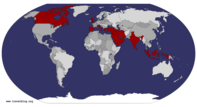Advertisement
Published: April 1st 2016

 Kuala Lumpur
Kuala Lumpur
Petronas TowersAlthough the itinerary for this voyage has been varied and stellar, the parking often leaves much to be desired. Like the ports for Yangon and Athens, Port Klang is quite far from the city center, and the ship charges too much for the one and a half hour bus transfer one-way. Nevertheless, it seemed the best bet to get to Kuala Lumpur, which seems to be a good walking city.
Although Port Klang is equipped with a spacious and modern cruise terminal, it is effectively empty but for an understocked and overpriced art store, a convenience mart, a souvenir shop and a huge waiting room with easily overtaxed wifi.
The bus was modern and comfortable, the guide informative and engaging. The ethnic makeup of this region is dramatically different again, with actual Malays barely breaking even, making up a little more than half of the K-L population. Chinese make up a full quarter and Indians dominate the remaining mixture. A large proportion of these are Muslim, with an equal number of Buddhist, and a smattering of Hindu and Christian. This results in a religious and culturally diverse population, seemingly mutually tolerant and coexisting peacefully.
An interesting Malay linguistic
affectation, similar to but less complex and varied than the Indonesian, "Ah," is, "Mmm." The population of Malaysia is X million, mmm. The Kuala-Lumpur Tower is almost 1400 feet tall, mmm. You are Canadian, mmm? You must be back at the meeting place by 3:30pm, mmm!"
We were dropped at a central shopping district where landmarks were pointed out to help us find our way back, mmm.
Kuala Lumpur itself is a big, lively, modern, flashy city. Downtown consists of cool architecture, mazes of busy streets, and deeply confusing pedestrian tunnels and overpasses with very poor signage which funnel through shopping malls and office towers.
Pizza joints, British-style pubs and KFCs dominate the streets, and arresting advertising is everywhere - billboards projected against buildings, moving ones with rolling ads changing every 10 seconds, huge tv screens showing mini-soap operas touting fashions, perfumes and jewelry.
There are two choices for elevated views of the city. The Kuala Lumpur Tower tops out at about 1400 feet and is the best view of the city and of the famous Petronas Towers, the tallest twin building in the world at about 1500 feet. The twin towers are the most popular tourist destination for views of the city, but really, the KL Tower is the better choice as the view combines the cityscape with the dominating twin towers and is the most dramatic.
Construction is everyfreakin'where in downtown and most of it inconveniently placed for pedestrians. Finding access to or even a n unobstructed view of the Petronas Towers was a challenge, and we took some arbitrary routes through underground passageways connected to pedestrian overpasses, threading an aquarium foyer and through uncountable underground mazes of malls with dramatic atriums.
We were finally rewarded when we popped out into a vast open area dominated by dancing fountains, and we could not help but gasp a little at the view of the twin towers, their glittering silver skin impossibly brightly burnished..
Getting out of the concrete jungle was a task in itself, but once we skirted the protected forest area that surrounds the K-L Tower, the neighborhoods got a lot more interesting and welcoming, with more green space and overall much less confining. The Lake Gardens comprise the Bird Park and an extravagant collection of orchids is rivaled only by the orchid gardens of Singapore. To the north of K-L Tower is the King's Palace, the sumptuous home of Sultan Mizan Zainal Abidin.
We were told that the history and culture of K-L lies in its ethnic neighborhoods and markets, and we certainly found much more character and interest there than in the concrete and glass of downtown, contemporary and original as it may be.
As in other SE Asian cities we have visited, the powerful gained control of the economy and workers arrived to support it. After the departure of the British colonisers, the Chinese community took over most business with labour coming from India. Thus here as elsewhere in SE Asia, multiculturalism is inescapable and integral to the community with Hindu temples, Buddhist shrines, Chinese clan houses and Islamic mosques side by side by side.
Seeking escape and respite from the concrete and glass and constant bombardment of loud, bright advertising, we passed by several restaurants where 'pullers' stand outside, pitching menus and specials trying to lure you in. We walked past a very out-of-place Irish pub flanked by a small Hindu shrine and a shiny office tower. A gangly, well-dressed Malay waiter with an improbably toothy smile stood on the porch and called out in a perfect Dublin accent, "Top o' the mornin' to ya, sir!"
We continued on through the Arab quarter, which seemed to be rather unfriendly with locals casting suspicious glances at us, the Arab men leering openly at pretty Indian women in their colourful saris.
We wound our way through Little India with its smells of spice and decaying produce to Independence Square, the center of the former British occupation in Malaysia.
We found the central mosque in the old part of town, but due to poor timing we were immediately told, "Excuse me, folks, you're not supposed to be here." Widespread and walled construction sites and ridiculously unnecessary pedestrian detours blocked access at almost every turn, and we were unable to get a good view of the reportedly beautiful mosque grounds.
A must-see is the covered market at Petaling Street, a colourful, varied and interesting market area chock-full of food and crafts shops (festooned with Do Not Photograph signs). This is where one can buy "genuine imitations" of almost any name brand. Knockoffs of Gucci, Oakley, and Swarovski accompany an inventively varied collection of jeans with labels of misspelled Levi's, Lee's and other sort-of brands.
Trademark theft aside, unlike other covered marketplaces this one is bright and roomy, and some specialised shops are enclosed with air conditioning. The nearby Central Market has been converted to an Arts and Crafts market, with artists willing to crank out oil paintings and watercolours on demand. Indeed, oil portraits of Jackie Chan, Myanmar's The Lady, Chairman Mao and Ghandi hang side by side, looking uncomfortably at their out-of-era neighbors.
Another fascinatingly ornate and huge Chinese clan temple, yet another ornate and huge Hindu temple, and line after dubious line of fast-food wok-equipped tables making dumplings and egg rolls and noodles in broth, up and down dark alleys and covered market areas.
We passed one table with duck and chicken parts spread out on the stained raw wood, next to another table with caged cats. This got my attention, and I was clearly not the first, as a hand-lettered sign said in English, "These cats are my PETS, they are not food. Thank you." Of course, the question remains as to why a seller of food would bring caged pet cats to work with her. . .
And of course, this would not be an exploratory excursion into a densely crowded city without pushing my way through a crowd and having Brainard tap me on the shoulder. "Hiya! Having fun?"
We made our way out of the ethnic areas and back into the urban canyons. The southern section is older, but no less congested, pedestrian-unfriendly, and maze-like. Trying to cross a street, we found ourselves trapped by four lanes of one-way traffic, never stopping and impossible to navigate, and a solid fence on the other. Further up, we saw two brave souls dash through traffic and reach our side safely. To be met by the impassible fence. But one guy boosted the other over the top, and managed to duck through. We could not see how this was done, but decided to take the chance and headed for that spot.
There was indeed a missing bar in the fence, big enough to let Jane through no problem, and I fit (barely) after removing my knapsack. We then had to climb a staircase leading to an elevated monorail station, which in turn led up some more stairs to a pedestrian bridge across the packed street. Then down, down, down to the enclosed street level where the humidity combined chokingly with the abundant engine exhaust.
I could occasionally spot a couple of landmarks, an Anglican church, a maternity hospital, a hotel, and as departure time for the bus drew near, we played an anxious game of left-right-left-right which got us to within easy reach of our meeting point with time to spare.
An excellent poker night again, my luck is due to run out soon. We are mostly having lots of laughs, except for the crabby old Sicilian guy who has his occasional tantrums, and the growing rivalry between two of the women. You can tell because they are so polite to each other face-to-face that it hurts, but obvious little hints of catty viciousness occasionally escape from one when the other isn't listening. Nevertheless, there have been wide-ranging and fun conversations with Bill and Igal and Sharon and Llyn and Angela and Rick and several other, and mostly with Krishna, the mild-mannered, dryly humourous and most professional poker dealer on the ship.
Ken told a story about having to get maintenance called to his cabin. The very kind-hearted and solicitous room steward saw the maintenance guy leaving Ken's room. "Mr. Ken, Mr, Ken! What is wrong?"
Ken told the poor man, "They found a guy hiding under my bed! He's been there for three weeks!"
The stricken steward stood in shock for some time, Ken having to reassure him multiple times that he really was just kidding.
Advertisement
Tot: 0.068s; Tpl: 0.018s; cc: 10; qc: 22; dbt: 0.0414s; 1; m:domysql w:travelblog (10.17.0.13); sld: 1;
; mem: 1.1mb









